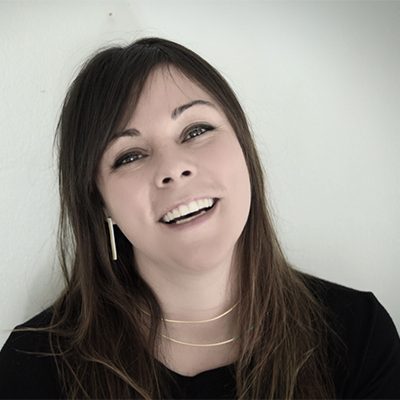The Art of Applied Computer Science

According to Ana Herruzo, chair of the Applied Computer Science (ACS) program in the School of Media Culture & Design, the department offers students the freedom and the opportunity to marry art and science, aesthetics and technique. The result is a STEM degree that prepares the next generation of media artists.
“Developing a unique curriculum in a new and up-and-coming field has been, to say the least, very exciting,” Ana says. “We use computer science as a tool to innovate in the fields of design, entertainment, and media. Computer science enables us to create exciting new territories in which to explore the field of media arts.” She describes her approach as “hands-on and experiential, where students learn by making and bringing their ideas to life.”
An architect, designer and programmer, Ana has been bringing ideas to life throughout her professional career, creating interactive environments for art galleries, corporate meeting spaces, concert arenas and architecture plans. “I always encourage design sensibility in parallel with improving technical skills,” she says. “That said, I mainly focus on critical thinking, guiding students into building an overall socio-cultural vision that will help create a robust and solid context for the development of their projects while pointing them toward their professional goals.”
Recently refreshed, the ACS program is a hybrid design/technology degree focusing on emerging digital practices by working with interactive environments, experiential design and human interaction. The program represents a new and inclusive approach to computer science, emphasizing real-world applications and skills aimed at making Woodbury graduates stand out.
Working and learning in a field defined by its dynamism, Ana’ students stay current with technology as a matter of course – for classroom success and for eventual careers. “Often, clients want a given project to use the latest technologies, so being connected in networks where creative innovation happens is key,” she says. “Research is absolutely critical in our field. My research is not purely theoretical, but a part of an applied and experimental project-based environment, either working on large scale, highly funded professional projects, or smaller artistic pieces to further my personal interests.”
Within ACS, the working world is, in a sense, both a laboratory and a proving ground, and Ana draws on her own eclectic roles — as media developer, art collective founder, maestro of interactive events, and more – to inform the curriculum. “I’m currently focusing on the field of ‘hybrid art,’ more specifically on the intersection of art and technology at a human and architectural scale,” Ana says. “In every project, I pay particular attention to exploring the dialogue between digital design environments and physical realities. Shifting from design disciplines to technical environments and back again has enabled me to bridge disciplines. And that’s what I seek to bring to the ACS program.
“What’s most gratifying is the positive feedback students receive when exhibiting their interactive installations during our annual showcase,” she says. “Witnessing their growth, their evolution and their eagerness to take on more challenging roles as they develop professional projects – there’s nothing quite like it.”